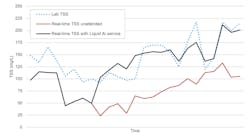Real-Time BOD Monitoring Ensures NPDES Compliance for Wastewater Effluent
To ensure that the quality of their wastewater effluent doesn’t violate permit limits, a gelatin manufacturer relies on Real Tech’s wastewater monitoring system for online and real-time BOD, TSS, and ammonium data. While providing strong peace of mind for NPDES permit compliance, the system also serves as a valuable process control tool that enables the operations team to catch events sooner. Data driven decisions made this way yield more appropriate actions and ensure that treatment goals are met.
Overview
A food manufacturing facility in the Midwestern United States produces gelatin, a protein derived from the collagen in animal parts. The production of gelatin generates large volumes of wastewater with high biochemical oxygen demand (BOD), suspended solids (SS), and ammonium/ammonia nitrogen (NH4/NH3-N) concentrations. The manufacturing facility manages this high strength wastewater onsite through treatment with dissolved air floatation (DAF) and aeration followed by four large lagoons. Effluent from the lagoons is then discharged directly into a local river.
Increased Production Strains WWTP, Jeopardizes Effluent Water Quality
Over the years, production at the facility has increased without corresponding updates to the wastewater treatment plant (WWTP). This has caused major challenges for the WWTP, prompting the environmental team to investigate solutions that would help manage these ongoing issues and aid in the better treatment of the wastewater effluent. Effluent quality is the highest priority for the environmental team as they strive to comply with EPA NPDES permit limits and ensure protection of their local water system. Of the pollutants monitored, biochemical oxygen demand (BOD), ammonium nitrogen (NH4-N) and total suspended solids (TSS) posed the greatest challenges.
Reducing BOD Turnaround Time from Days to Minutes
Delayed results from the lab, consistently 7 to 8 day turnaround time for BOD, significantly hindered the WWTP’s ability to react to different situations and meet treatment goals. This led the environmental team to Real Tech and their wastewater monitoring system that is capable of continuously monitoring BOD, TSS and NH4-N with high reliability and accuracy. The team was impressed by Real Tech’s ability to overcome the challenges most sensors face in harsh industrial wastewater environments.
Real Tech’s innovative solution combines a robust hardware sensor system with Liquid Ai data analytics support. This has enabled the plant to gain access to accurate and reliable real-time water quality data for complex parameters, such as BOD as shown in Figure 1, and eliminate the weeklong wait for insights into their effluent quality.
Taking Appropriate Actions to Achieve Compliance
With real-time visibility of their effluent water quality and high confidence in their data, the environmental team at the gelatin manufacturing site is now taking actions every day to improve treatment. Onsite staff have water quality data from the Real Tech system connected to their phones and receive immediate notification when water quality is approaching set thresholds. This allows the staff to not only respond sooner, but with more informed and appropriate actions to quickly and efficiently resolve issues.
The real-time data provides strong value by helping the plant ensure effluent water quality meets permit limits. The facility has the ability to blend wastewater that exceeds the daily concentration limit outlined in their permit with an onsite clean water source. This enables the plant to reduce their effluent concentration and avoid permit violations. The staff use data from the Real Tech system to aid with flow adjustments of the clean water and are then able to monitor to verify the changes made achieved the desired results.
Editor's Note: Scranton Gillette Communications and the SGC Water Group are not liable for the accuracy, efficacy and validity of the claims made in this piece. The views expressed in this content do not reflect the position of the editorial teams of Water & Wastes Digest, Water Quality Products and Storm Water Solutions.

